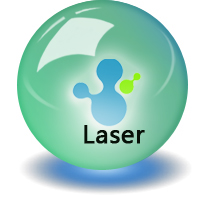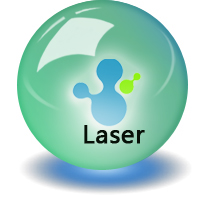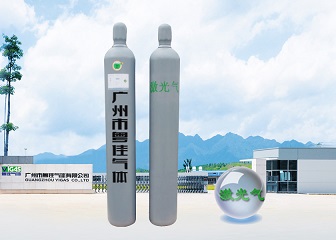热门下载
联系粤佳
广州市谱源气体有限公司


激光50年 激光器的输出波长在光谱上不断拓展
2011-10-27 9:49:13
《激光世界》网上新闻
激光50年 激光器的输出波长在光谱上不断拓展
早期,激光用户可选择的波长屈指可数。随着新的激光发射波长、谐波产生、可调谐激光器和非线性波长转换等产品和技术的出现,现在激光用户几乎可以实现任何想要的波长。
jeff hecht
在汽车大规模生产的初期,亨利•福特说客户只能购买到黑色的汽车。在激光器问世后的最初几年,寻求可见光激光器的用户只能获得红色的激光输出。虽然不久之后人们就在实验室中获得了更多的激光输出波长,但是商品化的很少,此后很多年激光用户只有较少的波长选择。
激光器输出波长的拓展已经走过了一条漫长的道路。现在,激光器输出波长的覆盖范围已经从量子级联激光器实现的太赫兹波段一直延伸到了自由电子激光器实现的x射线波段。新的激光器已经填补了光谱中的空白区,并且其中一些激光器是可调谐的。谐波产生、拉曼频移和混频技术,可以将激光输出移至新的波长。非线性光学可以在一个波长范围内拓展激光形成超连续谱。尽管人们还是不能获得任何想要的波长,但是一些大型激光展上展示的新的输出波长依然令人印象深刻,其中有许多激光波长都是在十年前无法实现的。
固定波长激光器
第一代激光器的输出属于已知能级之间的固定波长跃迁。梅曼发明的红宝石激光器是激光器发展历程中的一座里程碑,这不仅是因为它是世界上第一台激光器,而且还因为其输出的深红色激光输出很容易被肉眼观察到,这使得用它做实验非常容易。第一台氦氖(he-ne)激光器的输出波长为近红外波段的1153nm,但直到1962年贝尔实验室的alan white和dane rigden开发出632.8nm的红光he-ne激光器(见图1),he-ne激光器才获得了广泛应用。输出可见红光的氦氖激光器在科研和测量领域中成为了标准激光器,其应用范围从全息应用到下水道水管的调整等应用。
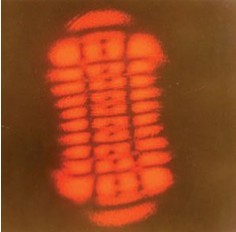
图1:贝尔实验室的第一台红光氦氖激光器产生的惊人高阶模图像。
随后,又有其他固定波长的激光器问世,覆盖的波长从从红外到紫外区域,但是这些产品很少被广泛使用。钕(nd)激光器成为了1.06µm的标准近红外光源,而co2激光器则成为了10.6µm的标准光源。氩离子、氪离子和氦镉激光器提供比氦氖激光器功率更高、波长更短的可见光输出,但是这些产品的价格更高、效率更低。输出波长为337nm的氮分子激光器成为标准的紫外激光器,直至20世纪70年代末才被稀有气体卤素激光器所取代。
固定波长激光器能够达到产生非线性效应并改变激光波长的高强度。1961年,密歇根大学的peter franken用红宝石激光照射石英晶体,第一次产生了红宝石的347nm二次谐波。[1]1962年,休斯研究实验室的gisela eckhardt和同事用红宝石脉冲照射硝基苯和其他液体时,观察到了受激拉曼散射。[2]更短的脉冲和更高的峰值功率产生了更多引人注目的效应。1970年,gte实验室的robert alfano和sidney shapiro报道了非线性效应混合产生了宽带超连续谱,他们观察到从400~700nm的可见光谱跨度。[3]
可调谐激光器
首次激光器调谐是通过磁场来移动能级,从而移动固定波长激光器的波长来实现的。此后,贝尔实验室的joe giordmaine和robert c. miller演示了铌酸锂中的光参量振荡。[4]但是,要实现较宽的可调谐激光输出,还要有机染料激光器的出现。
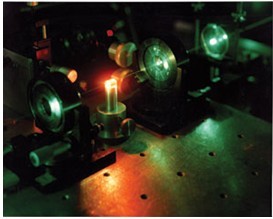
图2:麻省理工学院林肯实验室的peter moulton利用氩离子激光泵浦钛宝石。
1966年,ibm华生研究中心的peter sorokin和john lankard发现了染料激光器,他们将红宝石脉冲照射到氯铝酞菁染料溶液中时看到了较强的光发射。在染料盒旁边放置一对反射镜,产生的辐射太强以至于烧坏了膜上的乳胶。[5]1967年,休斯研究实验室的bernard soffer和b.b. mcfarland迈出了制造可调谐染料激光器的下一步,用一个衍射光栅替代一面腔镜,这样可以选择哪个波长在腔内振荡。[6]1970年,柯达公司的benjamin snavely研究小组使用氩离子激光器泵浦,实现了第一台连续输出的染料激光器。[7]
与传统的单色仪相比,可调谐染料激光器可以在一个窄光谱波段内提供高得多的功率,成为了强有力的研究工具。可调谐染料激光器使20世纪70年代产生了一系列光谱上得突破,包括1981年arthur schawlow获得诺贝尔物理学奖的工作。染料激光器仍然是具有许多实际缺点的复杂设备,包括染料寿命和光谱范围有限。
固态振动激光器是可调谐激光器发展中的另一大进展,其中发光离子同时改变振动和电子能级。麻省理工学院(mit)林肯实验室的peter moulton发明的钛宝石激光器,基本调谐范围为675~1100nm,远远超过任何染料激光器(见图2)。[8]钛宝石激光也可以倍频到较短的波长。
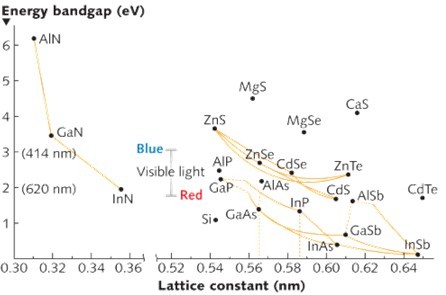
图3:具有激光手术所需的直接带隙的iii - v族化合物的半导体二极管激光器的波长与晶格间距之间的关系。
energy bandgap(ev):能量带隙(电子伏特)
lattice constant(nm):晶格常数(nm)
blue:蓝光
visible light:可见光
red:红光
半导体二极管激光器的增益带宽无法比拟钛宝石激光器,但可在谐振腔中实现可调谐。加州大学圣巴巴拉分校(ucsb)的larry coldren发明了取样光栅分布式布拉格反射激光器,其中一对具有不同周期的分布式布拉格反射镜作为腔镜。[9]电流或温度变化可改变光栅的共振,从而调谐激光。光纤传输器中的软件,可以将可调谐激光器的输出设定在一个固定的波长。
半导体激光器波长调节
半导体激光器的输出波长取决于发射层中材料的带隙。早期,半导体二极管激光器中的带隙由二元iii–v族化合物的性质决定,随后技术上的进步使得通过调节半导体的组分和结构来调节波长成为可能。
首先是发展三元化合物,如镓铝砷(gaalas),它能够与砷化镓(gaas)衬底晶格匹配,当铝的成分增加时,发射波长蓝移。然而,gaalas并不能够与gaas的晶格非常好地匹配,因此最关键的一步是四元化合物,如ingaasp,这提供了匹配晶格间距以及所需波长的第二个自由度。mit林肯实验室的j. jim hsieh实现了这一步,1977年他报道了室温下运行的ingaasp激光器输出1.25µm的激光。[10]随后不久,也是在inp衬底上,成分略有不同的ingaasp激光器问世,应用于1.3µm和1.55µm的低损耗光纤窗口。通过调整四种元素的组分,ingaasp激光器的输出波长覆盖了一个重要的波长范围(见图3)。
通过优化gaas衬底激光器的发射材料组分,可将其输出波长拓展到红光范围,例如使用algainp可使输出波长短至620nm。此后,1996年日亚公司(nichia)的shuji nakamura发明了氮化铟镓(gainn)半导体激光器,激光跨入了光谱的蓝光波段。[11]蓝光半导体激光器目前属于标准产品,但绿光半导体激光器仍然很难实现。在今年1月份的photonics west 2010会议上,startup kaai公司的nakamura报道已经开发出了523nm的ingan半导体激光器,填补了在半导体激光器在输出光谱中的空缺。
光泵浦使半导体激光器能够实现其他输出波长,同时避免了需要高电流密度通过半导体。这摆脱了设计上的约束,因此量子阱结构能够实现其他激光器无法得到的波长。泵浦二极管照射薄半导体碟片的表面,该碟片的表面附近具有量子阱层,量子阱在外腔中共振并发光,产生高强度、高质量的光束。这些装置被称为opsl(光泵浦半导体激光器)或vecsel(垂直外腔表面发射激光器),基本输出在近红外,可在激光腔内倍频成可见光。其设计可与特定波长匹配,如氦镉激光器的441nm激光,或治疗糖尿病视网膜病的557nm黄光。
另一种新颖的结构是1994年由贝尔实验室的federico capasso发明的量子级联激光器,这种激光器中的电子在一个偏置的半导体中通过量子阱堆叠。[12]在每个量子阱中,电子落到导带中更低的次能级,并发射一个光子,这个光子的波长取决于激光器的结构和组成。量子级联激光器提供了获得中、远红外波段难以实现的激光波长的方便途径,还可用于产生太赫兹频率。
其他激光源和展望
今天的激光光源目录提供了丰富的波长,这在激光时代的前几个十年中是很难想像的。此外,非线性光学提供了产生新的波长的强大工具。高功率飞秒脉冲的高次谐波产生,可以产生极紫外波段的相干光。非线性过程可以产生一个倍频程或更宽的超连续谱,以及飞秒频率梳,这是一项获得诺贝尔奖的创新,能够以惊人的精度测量光频。
现在,我们甚至可以在20世纪70年代john madey发明的自由电子激光器(fel)中产生自由电子的受激辐射。fel原理适用于从红外线到x射线范畴。今天,slac相干光源提供波长0.15~1.5nm的相干x射线。
激光器的输出波长已经走过了漫长的道路,我们现在有极为丰富的激光工具,用于各式各样的应用场合。当然,在接下来的半个世纪,我们在拓展激光器输出波长方面仍然面临着诸多挑战。
参考文献
1. p.a. franken et al, "generation of optical harmonics," phys. rev. lett. 7, p. 118 (aug. 15, 1961).
2. g. eckhardt et al, "stimulated raman scattering from organic liquids," phys. rev. lett. 9, p. 455 (dec. 1, 1962).
3. r.r. alfano and s.l. shapiro, phys. rev. lett. 24, p. 584 and 592 (mar. 16, 1970) r.r. alfano and s.l. shapiro, phys. rev. lett. 24, pp. 1217–1220 (june 1, 1970).
4. j.a. giordmaine and r.c. miller, "optical parametric oscillation in the visible spectrum," appl. phys. lett. 9, pp. 298–300 (1966).
5. p.p. sorokin and j.r. lankard, ibm journal of research and development 10, p. 162 (1966).
6. b.h. soffer and b.b. mcfarland, "continuously tunable narrow-band organic dye lasers," appl. phys. lett. 10, p. 266 (1967).
7. o.g. peterson et al., "cw operation of an organic dye solution laser," appl. phys. lett. 17, 6, p. 245 (1970).
8. p.f. moulton, "spectroscopic and laser characteristics of ti:al2o3," josa b 3, pp. 125–133 (january 1986).
9. s. lee et al, "integration of semiconductor laser amplifiers with sampled grating tunable lasers for wdm applications," ieee quantum electron. 33, pp. 615–627 (1997).
10. j.h. hsieh and c.c. shen, "room-temperature cw operation of buried-stripe double-heterostructure gainasp/inp diode lasers," appl. phys. lett. 30, p. 429 (apr. 15, 1977).
11. s. nakamura et al., "ingan-based multi-quantum-well-structure laser diodes," japan j. appl. phys. 2, 35(1b):l74-1 (1996).
12. j. faist et al., "quantum cascade laser," science 264 (5158), pp. 553–556 (april 1994).
________________________________________
梅曼的成就
2010年5月16日是世界上第一台激光器在梅曼的实验室中诞生50周年纪念日。梅曼发明的红宝石激光器不但在实验上实现了之前的设想,而且还为激光技术的发展完全打开了新的大门。
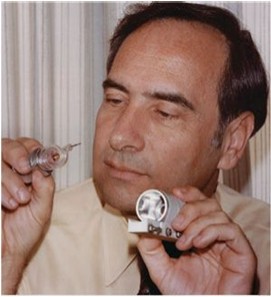
早前的概念将激光器设想为一个连续的光学振荡器,具有低增益和相对中等的功率。具有优势的候选方案是四能级系统,激光跃迁产生于初始激发态和最终基态之间的一对能级。到1960年底,人们分别在固体(掺铀氟化钙)和气体(氦氖)中实现了四能级激光器系统。
梅曼的红宝石激光器是三能级系统,光激发铬原子到高能级,随后铬原子跃迁到亚稳态,最后跃迁到基态,并产生受激辐射。传统观念认为红宝石不会产生受激辐射,因为其荧光效率低,并且很难实现粒子数反转。但是当梅曼独立测试红宝石时,却发现它的荧光效率其实非常高,这让梅曼看到了激光器的诞生希望。
随后,梅曼运用工程创造力巧妙地设计出了一台脉冲泵浦的红宝石激光器,泵浦灯是一个摄影用的闪光灯,其在短时间内将大多数铬原子激发脱离基态,产生了所需要的粒子数反转。当闪光灯的脉冲功率超过激光阈值时,梅曼观察到了人们之前预测的在激光振荡中会出现的红宝石发射谱线变窄的现象。
此外,梅曼还观察到了人们未曾预测到的现象:当闪光灯在小红宝石棒中反转粒子数时,在短暂间隔期间高增益的激光器产生了明亮的脉冲。而且,梅曼的激光器很容易制造,在几周内trg inc.公司、贝尔实验室等公司和研究机构就运行起了他们自己的红宝石激光器,并用吉列刀片测量脉冲功率——即激光能够穿透的刀片的数量。
现在看来,梅曼的发明可能再明显不过了,但那就是他天才的标志。像所有的发明家一样,他延伸了早期的工作,包括他自己开发的一个紧凑的红宝石微波激射器。他的成功建立在对红宝石和微波激射器的深刻理解的基础之上,同时其拥有的工程技能又使得他的红宝石激光器看起来非常简单。梅曼的贡献在于为激光器的发展指明了道路,让后来人与其一起推动激光器的发展。
jeff hecht
在汽车大规模生产的初期,亨利•福特说客户只能购买到黑色的汽车。在激光器问世后的最初几年,寻求可见光激光器的用户只能获得红色的激光输出。虽然不久之后人们就在实验室中获得了更多的激光输出波长,但是商品化的很少,此后很多年激光用户只有较少的波长选择。
激光器输出波长的拓展已经走过了一条漫长的道路。现在,激光器输出波长的覆盖范围已经从量子级联激光器实现的太赫兹波段一直延伸到了自由电子激光器实现的x射线波段。新的激光器已经填补了光谱中的空白区,并且其中一些激光器是可调谐的。谐波产生、拉曼频移和混频技术,可以将激光输出移至新的波长。非线性光学可以在一个波长范围内拓展激光形成超连续谱。尽管人们还是不能获得任何想要的波长,但是一些大型激光展上展示的新的输出波长依然令人印象深刻,其中有许多激光波长都是在十年前无法实现的。
固定波长激光器
第一代激光器的输出属于已知能级之间的固定波长跃迁。梅曼发明的红宝石激光器是激光器发展历程中的一座里程碑,这不仅是因为它是世界上第一台激光器,而且还因为其输出的深红色激光输出很容易被肉眼观察到,这使得用它做实验非常容易。第一台氦氖(he-ne)激光器的输出波长为近红外波段的1153nm,但直到1962年贝尔实验室的alan white和dane rigden开发出632.8nm的红光he-ne激光器(见图1),he-ne激光器才获得了广泛应用。输出可见红光的氦氖激光器在科研和测量领域中成为了标准激光器,其应用范围从全息应用到下水道水管的调整等应用。

图1:贝尔实验室的第一台红光氦氖激光器产生的惊人高阶模图像。
随后,又有其他固定波长的激光器问世,覆盖的波长从从红外到紫外区域,但是这些产品很少被广泛使用。钕(nd)激光器成为了1.06µm的标准近红外光源,而co2激光器则成为了10.6µm的标准光源。氩离子、氪离子和氦镉激光器提供比氦氖激光器功率更高、波长更短的可见光输出,但是这些产品的价格更高、效率更低。输出波长为337nm的氮分子激光器成为标准的紫外激光器,直至20世纪70年代末才被稀有气体卤素激光器所取代。
固定波长激光器能够达到产生非线性效应并改变激光波长的高强度。1961年,密歇根大学的peter franken用红宝石激光照射石英晶体,第一次产生了红宝石的347nm二次谐波。[1]1962年,休斯研究实验室的gisela eckhardt和同事用红宝石脉冲照射硝基苯和其他液体时,观察到了受激拉曼散射。[2]更短的脉冲和更高的峰值功率产生了更多引人注目的效应。1970年,gte实验室的robert alfano和sidney shapiro报道了非线性效应混合产生了宽带超连续谱,他们观察到从400~700nm的可见光谱跨度。[3]
可调谐激光器
首次激光器调谐是通过磁场来移动能级,从而移动固定波长激光器的波长来实现的。此后,贝尔实验室的joe giordmaine和robert c. miller演示了铌酸锂中的光参量振荡。[4]但是,要实现较宽的可调谐激光输出,还要有机染料激光器的出现。

图2:麻省理工学院林肯实验室的peter moulton利用氩离子激光泵浦钛宝石。
1966年,ibm华生研究中心的peter sorokin和john lankard发现了染料激光器,他们将红宝石脉冲照射到氯铝酞菁染料溶液中时看到了较强的光发射。在染料盒旁边放置一对反射镜,产生的辐射太强以至于烧坏了膜上的乳胶。[5]1967年,休斯研究实验室的bernard soffer和b.b. mcfarland迈出了制造可调谐染料激光器的下一步,用一个衍射光栅替代一面腔镜,这样可以选择哪个波长在腔内振荡。[6]1970年,柯达公司的benjamin snavely研究小组使用氩离子激光器泵浦,实现了第一台连续输出的染料激光器。[7]
与传统的单色仪相比,可调谐染料激光器可以在一个窄光谱波段内提供高得多的功率,成为了强有力的研究工具。可调谐染料激光器使20世纪70年代产生了一系列光谱上得突破,包括1981年arthur schawlow获得诺贝尔物理学奖的工作。染料激光器仍然是具有许多实际缺点的复杂设备,包括染料寿命和光谱范围有限。
固态振动激光器是可调谐激光器发展中的另一大进展,其中发光离子同时改变振动和电子能级。麻省理工学院(mit)林肯实验室的peter moulton发明的钛宝石激光器,基本调谐范围为675~1100nm,远远超过任何染料激光器(见图2)。[8]钛宝石激光也可以倍频到较短的波长。

图3:具有激光手术所需的直接带隙的iii - v族化合物的半导体二极管激光器的波长与晶格间距之间的关系。
energy bandgap(ev):能量带隙(电子伏特)
lattice constant(nm):晶格常数(nm)
blue:蓝光
visible light:可见光
red:红光
半导体二极管激光器的增益带宽无法比拟钛宝石激光器,但可在谐振腔中实现可调谐。加州大学圣巴巴拉分校(ucsb)的larry coldren发明了取样光栅分布式布拉格反射激光器,其中一对具有不同周期的分布式布拉格反射镜作为腔镜。[9]电流或温度变化可改变光栅的共振,从而调谐激光。光纤传输器中的软件,可以将可调谐激光器的输出设定在一个固定的波长。
半导体激光器波长调节
半导体激光器的输出波长取决于发射层中材料的带隙。早期,半导体二极管激光器中的带隙由二元iii–v族化合物的性质决定,随后技术上的进步使得通过调节半导体的组分和结构来调节波长成为可能。
首先是发展三元化合物,如镓铝砷(gaalas),它能够与砷化镓(gaas)衬底晶格匹配,当铝的成分增加时,发射波长蓝移。然而,gaalas并不能够与gaas的晶格非常好地匹配,因此最关键的一步是四元化合物,如ingaasp,这提供了匹配晶格间距以及所需波长的第二个自由度。mit林肯实验室的j. jim hsieh实现了这一步,1977年他报道了室温下运行的ingaasp激光器输出1.25µm的激光。[10]随后不久,也是在inp衬底上,成分略有不同的ingaasp激光器问世,应用于1.3µm和1.55µm的低损耗光纤窗口。通过调整四种元素的组分,ingaasp激光器的输出波长覆盖了一个重要的波长范围(见图3)。
通过优化gaas衬底激光器的发射材料组分,可将其输出波长拓展到红光范围,例如使用algainp可使输出波长短至620nm。此后,1996年日亚公司(nichia)的shuji nakamura发明了氮化铟镓(gainn)半导体激光器,激光跨入了光谱的蓝光波段。[11]蓝光半导体激光器目前属于标准产品,但绿光半导体激光器仍然很难实现。在今年1月份的photonics west 2010会议上,startup kaai公司的nakamura报道已经开发出了523nm的ingan半导体激光器,填补了在半导体激光器在输出光谱中的空缺。
光泵浦使半导体激光器能够实现其他输出波长,同时避免了需要高电流密度通过半导体。这摆脱了设计上的约束,因此量子阱结构能够实现其他激光器无法得到的波长。泵浦二极管照射薄半导体碟片的表面,该碟片的表面附近具有量子阱层,量子阱在外腔中共振并发光,产生高强度、高质量的光束。这些装置被称为opsl(光泵浦半导体激光器)或vecsel(垂直外腔表面发射激光器),基本输出在近红外,可在激光腔内倍频成可见光。其设计可与特定波长匹配,如氦镉激光器的441nm激光,或治疗糖尿病视网膜病的557nm黄光。
另一种新颖的结构是1994年由贝尔实验室的federico capasso发明的量子级联激光器,这种激光器中的电子在一个偏置的半导体中通过量子阱堆叠。[12]在每个量子阱中,电子落到导带中更低的次能级,并发射一个光子,这个光子的波长取决于激光器的结构和组成。量子级联激光器提供了获得中、远红外波段难以实现的激光波长的方便途径,还可用于产生太赫兹频率。
其他激光源和展望
今天的激光光源目录提供了丰富的波长,这在激光时代的前几个十年中是很难想像的。此外,非线性光学提供了产生新的波长的强大工具。高功率飞秒脉冲的高次谐波产生,可以产生极紫外波段的相干光。非线性过程可以产生一个倍频程或更宽的超连续谱,以及飞秒频率梳,这是一项获得诺贝尔奖的创新,能够以惊人的精度测量光频。
现在,我们甚至可以在20世纪70年代john madey发明的自由电子激光器(fel)中产生自由电子的受激辐射。fel原理适用于从红外线到x射线范畴。今天,slac相干光源提供波长0.15~1.5nm的相干x射线。
激光器的输出波长已经走过了漫长的道路,我们现在有极为丰富的激光工具,用于各式各样的应用场合。当然,在接下来的半个世纪,我们在拓展激光器输出波长方面仍然面临着诸多挑战。
参考文献
1. p.a. franken et al, "generation of optical harmonics," phys. rev. lett. 7, p. 118 (aug. 15, 1961).
2. g. eckhardt et al, "stimulated raman scattering from organic liquids," phys. rev. lett. 9, p. 455 (dec. 1, 1962).
3. r.r. alfano and s.l. shapiro, phys. rev. lett. 24, p. 584 and 592 (mar. 16, 1970) r.r. alfano and s.l. shapiro, phys. rev. lett. 24, pp. 1217–1220 (june 1, 1970).
4. j.a. giordmaine and r.c. miller, "optical parametric oscillation in the visible spectrum," appl. phys. lett. 9, pp. 298–300 (1966).
5. p.p. sorokin and j.r. lankard, ibm journal of research and development 10, p. 162 (1966).
6. b.h. soffer and b.b. mcfarland, "continuously tunable narrow-band organic dye lasers," appl. phys. lett. 10, p. 266 (1967).
7. o.g. peterson et al., "cw operation of an organic dye solution laser," appl. phys. lett. 17, 6, p. 245 (1970).
8. p.f. moulton, "spectroscopic and laser characteristics of ti:al2o3," josa b 3, pp. 125–133 (january 1986).
9. s. lee et al, "integration of semiconductor laser amplifiers with sampled grating tunable lasers for wdm applications," ieee quantum electron. 33, pp. 615–627 (1997).
10. j.h. hsieh and c.c. shen, "room-temperature cw operation of buried-stripe double-heterostructure gainasp/inp diode lasers," appl. phys. lett. 30, p. 429 (apr. 15, 1977).
11. s. nakamura et al., "ingan-based multi-quantum-well-structure laser diodes," japan j. appl. phys. 2, 35(1b):l74-1 (1996).
12. j. faist et al., "quantum cascade laser," science 264 (5158), pp. 553–556 (april 1994).
________________________________________
梅曼的成就
2010年5月16日是世界上第一台激光器在梅曼的实验室中诞生50周年纪念日。梅曼发明的红宝石激光器不但在实验上实现了之前的设想,而且还为激光技术的发展完全打开了新的大门。

早前的概念将激光器设想为一个连续的光学振荡器,具有低增益和相对中等的功率。具有优势的候选方案是四能级系统,激光跃迁产生于初始激发态和最终基态之间的一对能级。到1960年底,人们分别在固体(掺铀氟化钙)和气体(氦氖)中实现了四能级激光器系统。
梅曼的红宝石激光器是三能级系统,光激发铬原子到高能级,随后铬原子跃迁到亚稳态,最后跃迁到基态,并产生受激辐射。传统观念认为红宝石不会产生受激辐射,因为其荧光效率低,并且很难实现粒子数反转。但是当梅曼独立测试红宝石时,却发现它的荧光效率其实非常高,这让梅曼看到了激光器的诞生希望。
随后,梅曼运用工程创造力巧妙地设计出了一台脉冲泵浦的红宝石激光器,泵浦灯是一个摄影用的闪光灯,其在短时间内将大多数铬原子激发脱离基态,产生了所需要的粒子数反转。当闪光灯的脉冲功率超过激光阈值时,梅曼观察到了人们之前预测的在激光振荡中会出现的红宝石发射谱线变窄的现象。
此外,梅曼还观察到了人们未曾预测到的现象:当闪光灯在小红宝石棒中反转粒子数时,在短暂间隔期间高增益的激光器产生了明亮的脉冲。而且,梅曼的激光器很容易制造,在几周内trg inc.公司、贝尔实验室等公司和研究机构就运行起了他们自己的红宝石激光器,并用吉列刀片测量脉冲功率——即激光能够穿透的刀片的数量。
现在看来,梅曼的发明可能再明显不过了,但那就是他天才的标志。像所有的发明家一样,他延伸了早期的工作,包括他自己开发的一个紧凑的红宝石微波激射器。他的成功建立在对红宝石和微波激射器的深刻理解的基础之上,同时其拥有的工程技能又使得他的红宝石激光器看起来非常简单。梅曼的贡献在于为激光器的发展指明了道路,让后来人与其一起推动激光器的发展。




